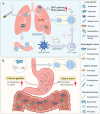Microbiota in Tumors: From Understanding to Application
- PMID: 35603968
- PMCID: PMC9313476
- DOI: 10.1002/advs.202200470
Microbiota in Tumors: From Understanding to Application
Abstract
Microbes with complex functions have been found to be a potential component in tumor microenvironments. Due to their low biomass and other obstacles, intratumor microbiota is poorly understood. Mucosal sites and normal adjacent tissues are important sources of intratumor microbiota, while hematogenous spread also leads to the invasion of microbes. Intratumor microbiota affects the progression of tumors through several mechanisms, such as DNA damage, activation of oncogenic pathways, induction of immunosuppression, and metabolization of drugs. Notably, in different types of tumors, the composition and abundance of intratumor microbiota are highly heterogeneous and may play different roles in the progression of tumors. Because of the concern in this field, several techniques such as omics and immunological methods have been used to study intratumor microbiota. Here, recent progress in this field is reviewed, including the potential sources of intratumor microbiota, their functions and related mechanisms, and their heterogeneity. Techniques that can be used to study intratumor microbiota are also discussed. Moreover, research is summarized into the development of strategies that can be used in antitumor treatment and prospects for possible future research in this field.
Keywords: anti-tumor therapy; intratumor microbiota; microbial community heterogeneity; omics technology; source of microbes; tumorigenesis.
© 2022 The Authors. Advanced Science published by Wiley-VCH GmbH.
Conflict of interest statement
The authors declare no conflict of interest.
Figures







Similar articles
-
Emerging roles of intratumoral microbiota: a key to novel cancer therapies.Front Oncol. 2025 Feb 25;15:1506577. doi: 10.3389/fonc.2025.1506577. eCollection 2025. Front Oncol. 2025. PMID: 40071093 Free PMC article. Review.
-
Emerging roles of intratumor microbiota in cancer: tumorigenesis and management strategies.J Transl Med. 2024 Sep 11;22(1):837. doi: 10.1186/s12967-024-05640-7. J Transl Med. 2024. PMID: 39261861 Free PMC article. Review.
-
Relevance of harmful intratumoral microbiota in cancer progression and its clinical application.Biomed Pharmacother. 2024 Sep;178:117238. doi: 10.1016/j.biopha.2024.117238. Epub 2024 Aug 5. Biomed Pharmacother. 2024. PMID: 39106707 Review.
-
Potential role of intratumor bacteria outside the gastrointestinal tract: More than passengers.Cancer Med. 2023 Aug;12(16):16756-16773. doi: 10.1002/cam4.6298. Epub 2023 Jun 28. Cancer Med. 2023. PMID: 37377377 Free PMC article. Review.
-
Intratumor microbiota in cancer pathogenesis and immunity: from mechanisms of action to therapeutic opportunities.Front Immunol. 2023 Oct 6;14:1269054. doi: 10.3389/fimmu.2023.1269054. eCollection 2023. Front Immunol. 2023. PMID: 37868956 Free PMC article. Review.
Cited by
-
The role of fungi in the diagnosis of colorectal cancer.Mycology. 2023 Sep 3;15(1):17-29. doi: 10.1080/21501203.2023.2249492. eCollection 2024. Mycology. 2023. PMID: 38558845 Free PMC article. Review.
-
Heat-killed Prevotella intermedia promotes the progression of oral squamous cell carcinoma by inhibiting the expression of tumor suppressors and affecting the tumor microenvironment.Exp Hematol Oncol. 2024 Mar 21;13(1):33. doi: 10.1186/s40164-024-00500-y. Exp Hematol Oncol. 2024. PMID: 38515216 Free PMC article.
-
Intratumoral microbiota: an emerging force in diagnosing and treating hepatocellular carcinoma.Med Oncol. 2024 Oct 25;41(12):300. doi: 10.1007/s12032-024-02545-9. Med Oncol. 2024. PMID: 39453562 Review.
-
Fungal influence on immune cells and inflammatory responses in the tumor microenvironment (Review).Oncol Lett. 2024 Nov 11;29(1):50. doi: 10.3892/ol.2024.14796. eCollection 2025 Jan. Oncol Lett. 2024. PMID: 39564373 Free PMC article. Review.
-
Microbiome and metabolome analysis in smoking and non-smoking pancreatic ductal adenocarcinoma patients.BMC Microbiol. 2024 Dec 27;24(1):541. doi: 10.1186/s12866-024-03688-5. BMC Microbiol. 2024. PMID: 39731043 Free PMC article.
References
Publication types
MeSH terms
Grants and funding
LinkOut - more resources
Full Text Sources
Medical
